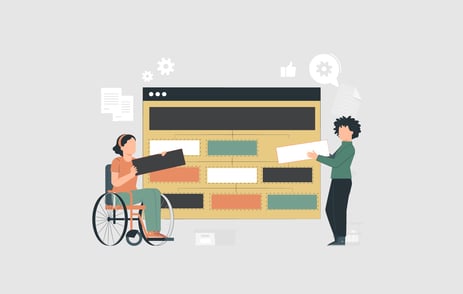In today's digital age, online courses have become an essential tool for associations to educate and train their members and staff. However, it's important to ensure these courses are accessible to all individuals. Read on to learn the importance of digital accessibility, along with best practices to ensure your organization’s professional development can work for everyone.
What Is Digital Accessibility?
Adult learners are a diverse group with various abilities, backgrounds, and experiences. According to the CDC, “up to 1 in 4 adults in the United States have some type of disability.” Some may have visual, hearing, or motor impairments that affect their ability to access and engage with online course materials.
Digital accessibility refers to the ability of individuals with disabilities to access and use digital technologies. This includes online courses, which must be designed in a way that is accessible to everyone, regardless of their physical or cognitive abilities.
By designing courses with digital accessibility in mind, you can ensure that all learners have equal access to course materials, can participate fully in online learning and have a positive learning experience.
Why Is Digital Accessibility Important for Online Courses?
Online courses have become a significant tool for education, training and career development. While ensuring they’re accessible to individuals with disabilities provides equal opportunities for learning and skill development, there are other crucial reasons it should be top of mind for associations producing educational content, including:
- Legal requirements: Like other digital content, online courses are subject to accessibility laws such as the Americans with Disabilities Act (ADA) and the Web Content Accessibility Guidelines (WCAG). Failure to comply with these regulations can result in legal action against the institution.
- Ethical considerations: Inclusivity is a fundamental value in education. Ensuring that all learners have access to course content and tools is an ethical imperative.
- Better learning outcomes: By making online courses accessible, organizations can ensure that all learners can fully engage with the content and participate in discussions and activities. This can lead to better learning outcomes and improved learner satisfaction.
What Does Digital Accessibility Look Like for Online Courses?
This involves designing courses in a way that accommodates various disabilities, such as visual impairments, hearing impairments, motor impairments and cognitive impairments. Associations can ensure digital accessibility for their online courses by following some best practices, including:
- Using Accessible Document Formats: Using accessible document formats, such as PDFs with proper tags and structure, is crucial for digital accessibility. Properly tagged and structured PDFs make it easier for individuals with disabilities, such as visual impairments or dyslexia, to access and understand the content.
- Provide Alt Text for Images: Images that support instruction are a key component of online courses, but they can be challenging for people with visual impairments. To make images accessible, the course should have alternative text descriptions that describe the image's content and purpose.
- Using High-Contrast Colors: Color contrast is the difference in brightness between foreground and background colors. For accessibility purposes, aim for a 4.5:1 ratio between the foreground color (e.g. text, links, etc.) and the background color. High-contrast colors make it easier for people with visual impairments to read text on a screen. Web Aim’s Contrast Checker is a free tool (and a personal favorite) to use when checking font color accessibility.
- Use Closed Captions and Transcripts for Videos: Videos are another essential component of online courses, but they can be difficult for people with hearing impairments. Associations should provide closed captions or transcripts for all videos to ensure everyone can access the content.
- Ensure Keyboard Accessibility: Keyboard accessibility is crucial for people with motor impairments who may not be able to use a mouse. When creating a course, it’s important to ensure that all interactive elements, such as buttons and links, can be accessed using a keyboard.
- Provide Clear and Consistent Navigation: Navigation is essential for online courses, and it's crucial to ensure it's clear and consistent. Make sure to provide a logical and predictable structure for an online course, with clear headings and menus.
- Test for Accessibility: Associations should test their online courses for accessibility to ensure they meet accessibility standards. There are several tools available, such as screen readers and keyboard-only navigation, which can help test for accessibility.
Digital accessibility is important for ensuring that online courses are inclusive and accessible to all learners. By following best practices for digital accessibility, online courses can be designed in a way that accommodates a wide range of abilities and learning styles, making online learning more equitable and effective.

March 23, 2023


